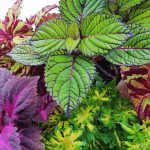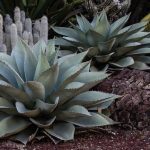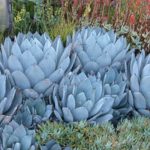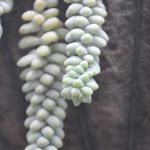Agave plants are commonly associated with arid regions, but some varieties can withstand winter temperatures as low as 10 degrees Fahrenheit. Whether you opt to cultivate agave indoors in pots or outdoors in your garden, there’s a suitable variety for every setting! Dive into the world of agaves with gardening expert Kelli Klein and explore 13 exceptional varieties for your indoor or outdoor space.
Indoor Varieties
Why consider growing agave? These easy-care plants can enhance the aesthetic appeal of your indoor plant collection as well as your outdoor landscape with their striking foliage. Most agave varieties bloom at least once during their lifespan. Growing agave both indoors and outdoors comes with its unique set of advantages and challenges.
Indoor cultivation requires selecting compact varieties that thrive in containers. Since indoor conditions can be controlled, factors like climate and growth zones are not major concerns. Bright, sunny windows are ideal for indoor agaves, and ensuring the soil dries out completely between waterings is essential.
In contrast, when opting to grow agave outdoors, the plant’s mature size becomes less critical as they are not confined to pots. Outdoor agave choices can range from small to giant, with some varieties growing up to 10 feet tall and wide. Consideration of your USDA plant hardiness zone is vital for outdoor cultivation, especially in regions with cold winters.
Agave varieties suitable for indoor growth are often miniature yet visually stunning. Each type boasts unique foliage, making them perfect for adorning windowsills with their beauty. These low-maintenance plants do not demand excessive care, and overwatering or overfertilizing should be avoided to ensure their longevity.
When cultivating agave indoors, opt for containers with drainage holes to prevent waterlogging. Eliminate saucers to avoid stagnant water, which could be detrimental to plant health. Most indoor varieties can also thrive outdoors if desired.
Blue Glow
‘Blue Glow’ Agave, a recent hybrid of Agave attenuata and Agave ocahui, stands out with its exquisite dark blue-green leaves accented by yellow and red edges. When backlit by the sun, the margins of these leaves appear to glow, inspiring the cultivar’s name ‘Blue Glow’. This variety flourishes best in full sun and can adapt to partial sunlight. With a mature size of two to three feet in height and width, it is an excellent choice for indoor container gardening.
Artichoke
Characterized by broad blue leaves with maroon spines resembling an artichoke, Agave parryi var. Truncata, also known as Artichoke Agave, hails from Central Mexico, endowing it with exceptional drought tolerance and minimal maintenance needs. Thriving under full sun, artificial methods like reflective surfaces or indoor grow lights can supplement sunlight indoors. With a mature size of two feet tall and three feet wide, it fits perfectly in indoor spaces.
Twin Flowered


Agave geminiflora, also called twin-flowered agave, displays long, slender leaves, giving it a unique appearance among agaves, reminiscent of a pin cushion. This distinguishing feature can bring an air of novelty to your indoor succulent collection.
Being most successful in full sunlight, this plant can thrive indoors if it receives reflected sunlight. When fully grown, it typically stands three feet tall and spreads out four feet wide.
Agave schidigera
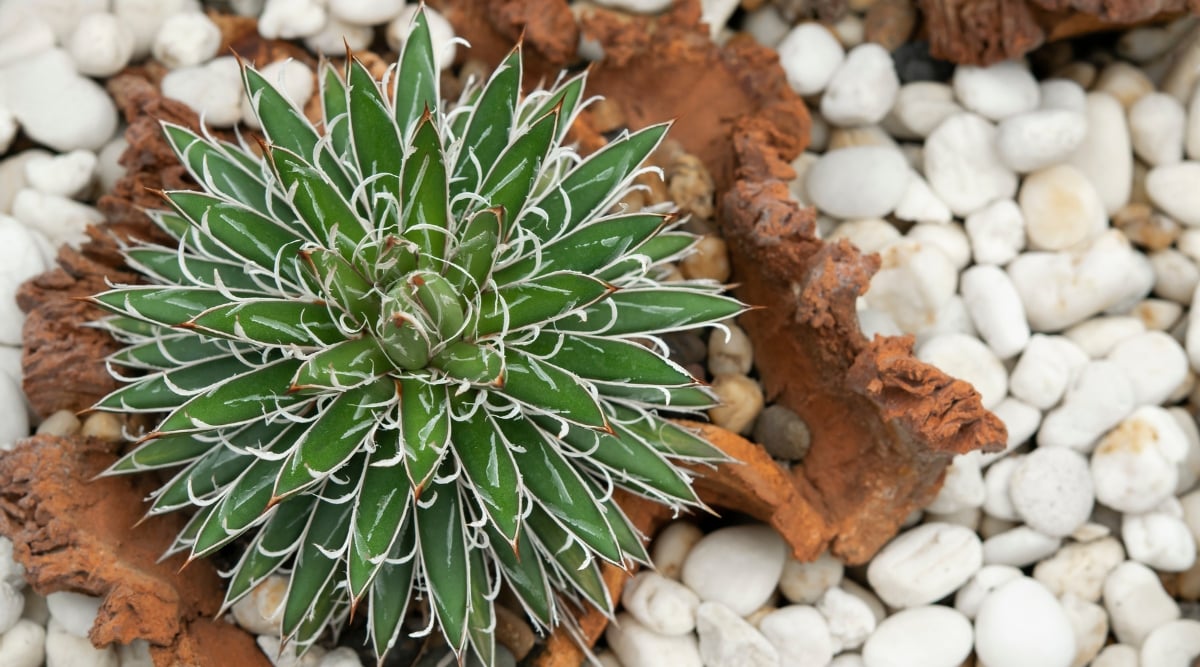

Agave schidigera features curly white fibers on its bright green leaves, boasting white marks that enhance the greenery’s contrast. This type hails from central Mexico.
It necessitates full sun or partly filtered afternoon shade for optimal growth. When fully mature, it tends to reach one foot in height and stretches one to two feet wide.
King Ferdinand
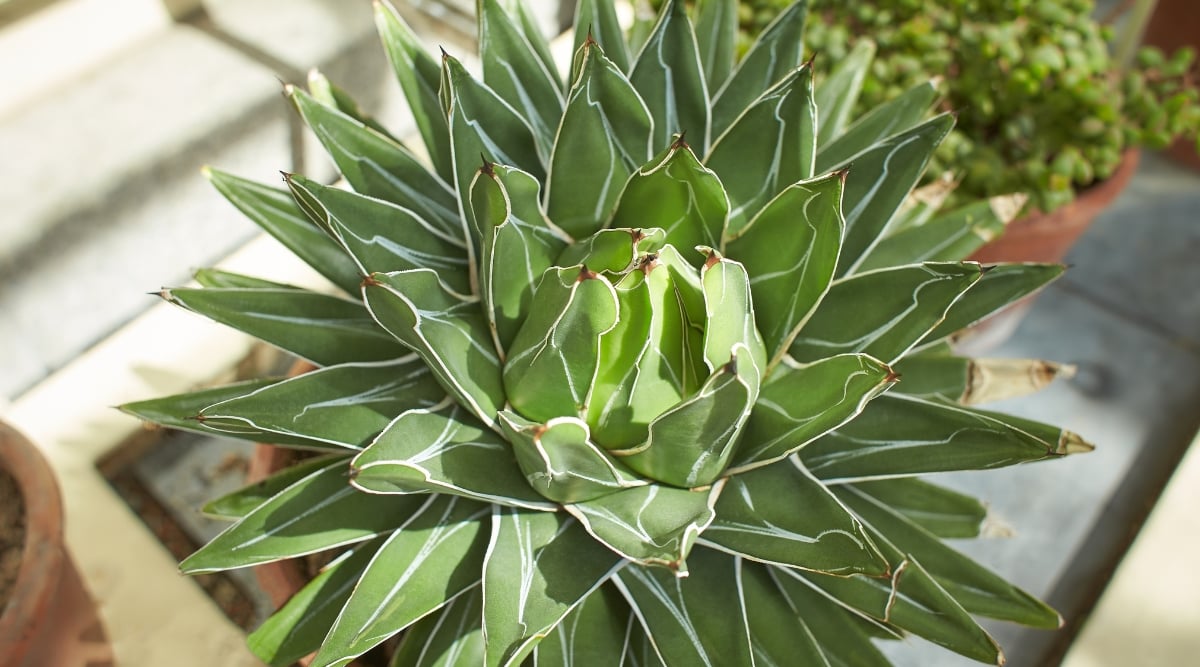

Agave Ferdinandi Regis, resembling ‘Queen Victoria’ Agave, was once thought to be a natural hybrid of Agave victoriae-reginae, but it is its distinct variety.
Commonly known as King of The Agaves, this type boasts dark green leaves with white edges and sharp tips, growing in an attractive open rosette ideal for containers. For thriving growth, it requires abundant sunlight, making it suitable for bright indoor spots. At maturity, it tends to reach heights and widths of one to two feet.
‘Compacta’ Queen Victoria

Agave victoriae-reginae ‘Compacta’ is a charming variety that fits well in containers, and you can find it enchanting desert botanical gardens, where it stands out as one of the most aesthetically pleasing agaves.
Featuring dark green leaves with vivid white markings, this type, compared to the mentioned ‘King Ferdinand’, offers even greater contrast. To thrive, it necessitates abundant sunlight, especially if grown indoors near a sunny window. When fully matured, it reaches under a foot in height and spans one to two feet in width.
Outdoor Varieties
Choose an agave for outdoor growth that corresponds with your USDA growing zone, indicating the typical low temperature in your region. This is crucial for perennial plants like agaves, which need to endure outdoor winter conditions.
Primarily originating from the Southern U.S., Central Mexico, the Caribbean, and South America, agaves thrive in regions like the Southwest and Mediterranean, offering some cold-resistant varieties yet necessitating well-drained soil to avoid damage and plant demise during colder months.
Golden Flowered Century Plant

Agave chrysantha, the Golden Flowered Century Plant, is an evergreen beauty with a perfectly formed rosette of grey-green leaves. Its leaves, adorned with spines along the edges and a sharp terminal spine, grow in a rounded mound shape.
This variety demands full sun and well-drained soil, boasting resistance to both drought and deer. At maturity, it reaches a height of two to three feet and expands to four to five feet in width.
Harvard
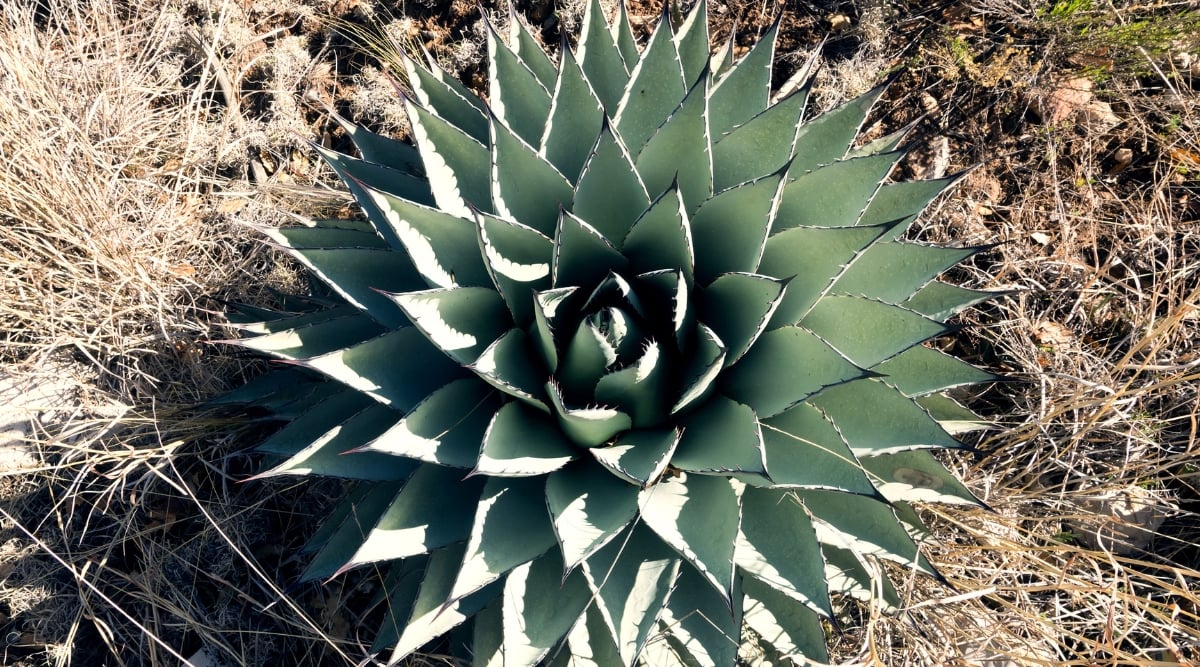

Harvard Agave, also known as ‘Agave havardiana’, boasts stunning silver-gray foliage with broad, fleshy, cupped leaves adorned with dark brown teeth and a sharp black terminal spine.
This variety is tailor-made for extreme cold resilience, flourishing in USDA zones 5-10, enduring temperatures as low as -20 degrees Fahrenheit (-29 degrees Celsius). It thrives best in full-sun spots, especially during winter when the sun sits lower in the sky. Harvard Agave reaches a mature size of two to three feet tall and three to four feet wide.
Mountain Agave

Mountain Agave, or Agave montana, resembles a large artichoke with broad, upright, apple-green leaves featuring large cinnamon-red teeth along the margins and a short terminal spine. Unlike many agaves, this solitary plant does not produce offshoots or pups.
This agave flourishes in USDA zones 7-10 and can withstand temperatures as low as 10 degrees Fahrenheit (-12 degrees Celsius), thriving in full sun to partial shade conditions. At maturity, it reaches a height of three to four feet and a width of four to five feet.
Narrow Leaf Century Plant
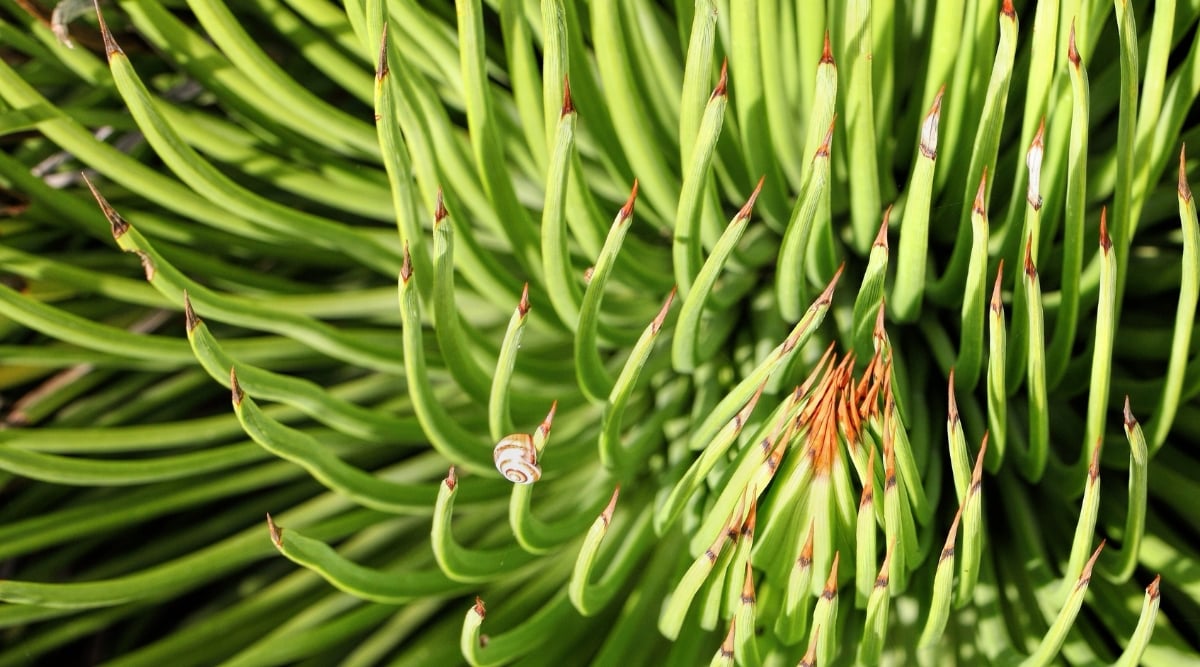
Narrow Leaf Century Plant, or Agave striata, showcases long, slender gray-green leaves with a brown terminal spine. This variety, known for its slight purple tones in cold weather, produces abundant offshoots, perfect for propagation.
It thrives in USDA zones 7-11, enduring temperatures as low as 10 degrees Fahrenheit (-12 degrees Celsius), requiring a full-sun location for optimal growth. At full maturity, it stands one to two feet tall and two to three feet wide.
Whale’s Tongue
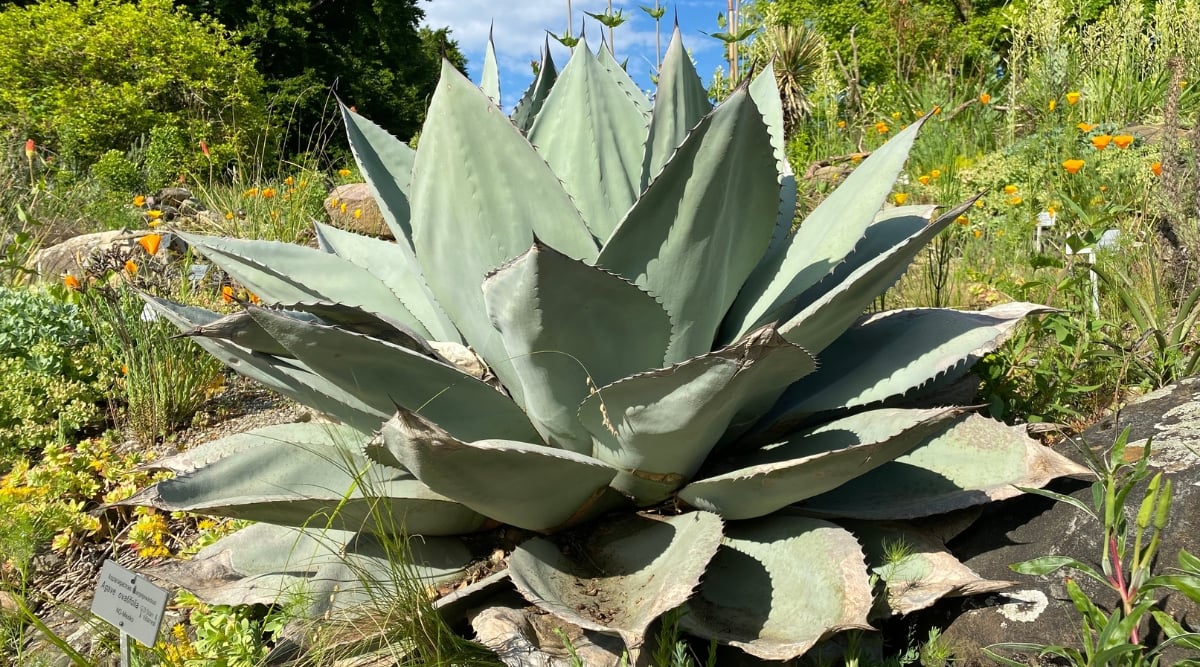
Whale’s tongue agave, scientifically named Agave ovatifolia, boasts broad cup-shaped leaves that come in shades varying from gray to powdery blue, resembling the coloration of a whale’s tongue. Lined with teeth along the edges and topped with a tall terminal spine, this agave makes a captivating addition to any landscape.
The Whale tongue agave can flourish in USDA growing zones 7-11, withstanding temperatures as cold as 10 degrees Fahrenheit. Requiring full sun exposure, this agave reaches a mature size of three to four feet in height and four to six feet in width.
Cabbage Head
Renowned as Agave parrasana or cabbage head agave, this variety resembles a tightly packed head of cabbage with its slow-growing rosette of overlapping blue-gray leaves. The recipient of the Award of Garden Merit from the Royal Horticultural Society, this agave is a visual delight.
Cabbage head agave is suitable for USDA growing zones 7-11, capable of withstanding temperatures as low as 10 degrees Fahrenheit. Preferring full sun and slightly acidic, sandy soil, this agave matures to a height and width of one to two feet, occasionally sprouting a tall flower stalk up to 20 feet in height.
Queen Victoria Century Plant
Known as Agave victoriae-reginae or the ‘Queen Victoria’ century plant, this remarkable agave variety is a standout choice for outdoor landscaping. Sharing the same characteristics as the compact indoor version, this agave features dark green leaves with striking white markings, a true beauty in any outdoor setting.
This agave can be cultivated in USDA growing zones 7-11, surviving temperatures as low as 10 degrees Fahrenheit. Requiring ample sunlight for optimal leaf growth, the mature Queen Victoria century plant reaches one foot in height and one to two feet in width.
Final Thoughts
Integrating agaves into your indoor plant collection or outdoor landscape can introduce a low-maintenance element. Despite the general association with warm and arid climates, certain agave varieties can adapt to cooler temperatures. For North American regions, selecting agave varieties native to your area ensures thriving plants in your specific climate.


